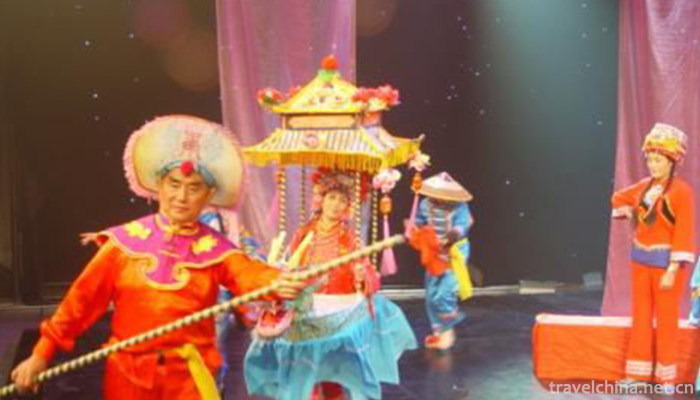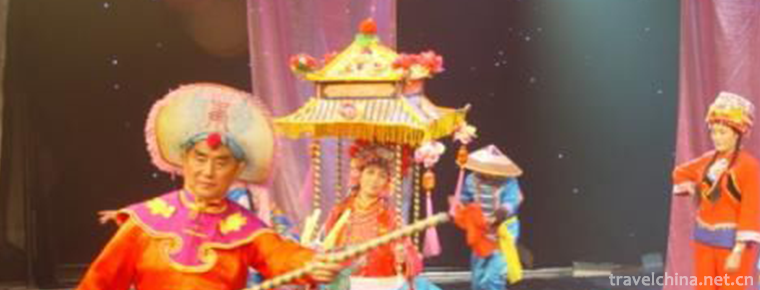Lichuan lantern song
Lichuan lantern song
Lichuan Lantern Song is a traditional folk dance that originated in Baiyang area of Lichuan City. Many folk songs in Lichuan Lantern Song and the ancient bamboo branch song inherit in one continuous line, which have high national cultural and artistic value. It has been recorded that from the Qing Dynasty, the masses sang lanterns and songs during the festivals, festive gatherings and dragon boats.
On May 23, 2011, Lichuan Lantern Song was approved by the State Council to be included in the third batch of national intangible cultural heritage list.
Historical evolution
Lichuan Lantern Song is an ancient folk song, which began in the early Qing Dynasty and has a history of more than 300 years. As the saying goes, "Thirty nights of fire, fifteen nights of light," Lichuan lantern songs and the Spring Festival customs are closely related. From the Qing Dynasty to the Republic of China, Lichuan people's custom of playing with lanterns rose widely, which was a collective recreational activity between festivals. Performers also dress up, commonly known as "lamp show", which has a little dramatic flavor.
After the founding of New China, the lanterns playing immortals and ghosts and a large number of lanterns singing about love were cancelled, but the Dragon lanterns, lions and lotus boats and car lights in the "last eight" and "miscellaneous lanterns" survived. In the Cultural Revolution, the lamp song stopped. Since the reform and opening up, although the performance of lotus boats and car lights has long lost its former brilliance, its performance time has gradually expanded from the New Year to all festive gatherings and leisure, from a custom to a popular cultural singing and dancing activities that can be carried out at any time.
artistic characteristics
Lichuan Lantern Song is a folk singing form of the Tujia people in Lichuan, which carries songs, dances and paddles the floor for the festivals and festivals, mainly with the dragon boats as props.
Representative works
"Dragon Boat Tune" is the representative work of Lichuan Lantern Song. Lichuan Lantern Song is the mother of "Dragon Boat Tune". Dragon Boat Tune, also known as Lantern Tune, Flower Lantern, Seed Melon Tune and Melon Seed Ren Tune, is a tune sung by the masses during the festival when they are rowing for lotus boats, and is a genuine Lichuan folk song.
In February 1956, Zhou Xuqing and Huang Yewei, cadres of Lichuan County Cultural Museum, collected seed melon tunes in Boyang and named them Dragon Boat Tunes. In March 1957, Wang Guosheng and Zhang Shuntang, peasant singers of Wangying Town, sang Dragon Boat Tune at the 2nd National Folk Music and Dance Competition held in Beijing, which won unanimous praise. In May 1962, "Dragon Boat Diao" was included in "Hubei Folk Songs Collection", which was released by the Central People's Radio Station. In 1979, Dragon Boat Tune was included in the Collection of Chinese Folk Songs. In recent decades, "Dragon Boat Tune" has landed on CCTV and the world stage many times. Wang Jieshi, Cheris, Wei Jindong, Meng Pigeon, Zhang Ye, Tang Can and other famous singers have sung one after another, with their charm and influence expanding. China's manned spacecraft also took it into space when it went into space. In 2004, Song Zuying sang a song "Dragon Boat Tune" in the Golden Hall of Vienna, which caused a sensation in the world music circle.
"Dragon Boat Tune" is only one of Lichuan's lamp songs, and "Dragon Boat Tune" is also mainly due to the collection and collation of the people's singing, so it is very famous. There are many representative works of Lichuan Lantern Songs, such as "Singing Mountain Songs for Lovers" and "Closing Eyes on a Sieve" which belong to the category of Lichuan Lantern Songs.
Inheritance significance
Lichuan is a treasure house of folk songs and dances, as well as national folk culture. There are many excellent national cultures waiting to be further excavated and sorted out. What is left behind by cultural heritage is not always good. We must learn to make the past serve the present, discard the dross and retain its essence, so that our cultural elements of national culture will continue to flourish.


-
1.Mount Wuyi
Wuyi Mountain, Wuyi Mountain is located at the junction of Jiangxi and northwest Fujian Province. The southeastern foot of Wuyi Mountain has a total area of 999.75 square kilometers. It is a famous sc
Time 2018-10-28 -
2.Drifting in Baotianbang Canyon
Baotianbang Canyon Drifting Scenic Area is located in Neixiang County, Nanyang City, Henan Province, which is an excellent tourist city in China. Baotianman is the only World Biosphere Reserve in Hena
Time 2019-01-02 -
3.qingdao olympic sailing center
Qingdao Olympic Sailing Center Scenic Spot is located in Fushan Bay, Qingdao City, and Qingdao's landmark scenic spot - May 4th Square offshore, covering an area of about 45 hectares
Time 2019-02-07 -
4.Saint Sophia Cathedral in Harbin
St. Sophia Church is located in Sophia Square, Daoli District, Harbin City, Heilongjiang Province, China. It is a Byzantine-style Orthodox Church built in 1907
Time 2019-02-08 -
5.Shuimogou Scenic Area
Shuimogou Scenic Area, also known as Shuimogou Park, is named after Shuimogou in the scenic area. It is located in the eastern suburb of Urumqi, Xinjiang. Around 2000
Time 2019-02-13 -
6.Tea ceremony
Tea art is a kind of culture. On the basis of Chinese excellent culture, tea art has absorbed and borrowed other art forms extensively, and expanded to literature, art and other fields
Time 2019-04-15 -
7.Ha Ni Ha Ba
Ha Ni Ha Ba, an important part of Chinese Hani folk literature. Hani Haba, which means Hani ancient songs, is a popular and far-reaching folk song in Hani social life.
Time 2019-05-02 -
8.Black On White
The Black-and-White War is a comic book about the Naxi epic Black-and-White War, which consists of seven chapters.
Time 2019-05-03 -
9.Wood Engraving Picture
In Chinese folklore, New Year's pictures are the symbol of the New Year. If they are not pasted, they will not be counted as the New Year's Day. New Year pictures are not only decorations for festival
Time 2019-06-05 -
10.Zhuxian Town Wood Print New Year Picture
Zhuxianzhen Wood Engraving New Year Picture is one of the ancient Chinese traditional crafts. As the originator of Chinese woodcut New Year pictures, is mainly distributed in Kaifeng, Zhuxian Town and
Time 2019-08-10 -
11.Dragon elbow mountain
Longcub mountain, also known as yuxu mountain, is located in Longquan Township, northwest of Huili County, Liangshan Yi Autonomous Prefecture, Sichuan Province, China. It is also known as yuxu mountain at the junction of Baiguowan
Time 2020-10-16 -
12.Dazhou social security
In 2019, the per capita disposable income of Dazhou residents is 22995 yuan, an increase of 10.1%. The per capita disposable income of urban residents was 33823 yuan, an increase of 9.5%. Among them, salary income was 18783 yuan, an increa
Time 2020-12-20